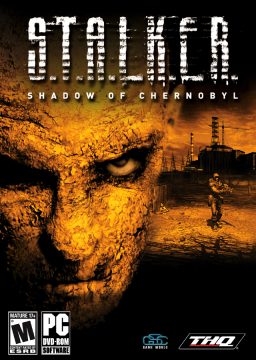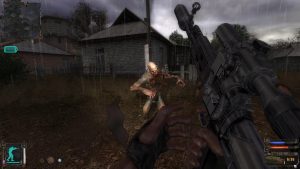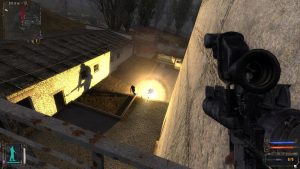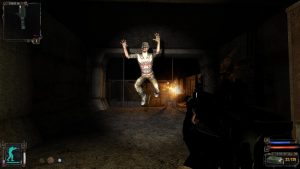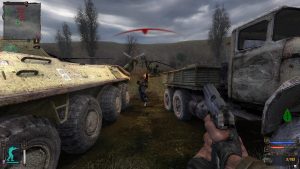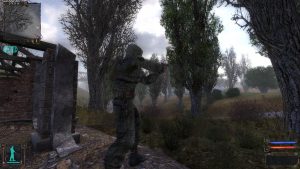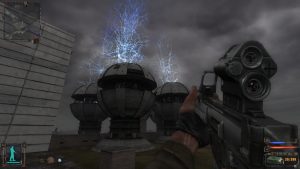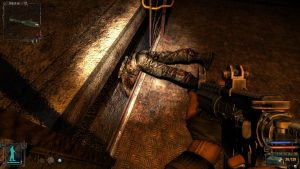- STALKER: Shadow of Chernobyl
- S.T.A.L.K.E.R.: Clear Sky
- S.T.A.L.K.E.R.: Call of Pripyat
The Chernobyl nuclear disaster happened in 1986. Reactor 4 of the Chernobyl Nuclear Power plant exploded, unleashing airborne radioactive pollution into the atmosphere. The event was to have dire effects for the surrounding area as well as the rest of Europe. Although the disaster occurred nearly three decades ago, the threat seemingly over, it has had a lasting legacy on the Ukraine and the rest of the former Soviet states. The Wall may have fallen four years later, but for many this was the precursor to the collapse of the Soviet Union. As governments changed the disaster zone was left in the intervening years, abandoned, uninhabitable, and burdened with rusting relics from another era. The zone was a trash-laden and scarred landscape left as legacy by a once mighty power.
Roadside Picnic, a book written by the Strugatsky brothers well before the Chernobyl disaster, describes aliens landing briefly on earth and leaving both terror and wonderment in their wake. A scientist in the book likens these visits to a “roadside picnic” in which people briefly stop by the roadside and eat their lunch, leaving their scraps and trash for the ants to discover. In the book men called stalkers risk their lives entering these “zones” to see what these unfathomable alien beings have discarded for humanity to find.
Splinters of Soviet Empire are plentiful in Ukraine – forgotten productions, catacombs, neglected military facilities and so on. Even our office is located at an ex-military factory with no more active production. When walking around such areas you can’t but think how the time froze at this place of man-made catastrophe. Logically, it struck us as a cool game setting to explore.
– Project Lead Anton Bolshakov in PC Gamer UK, September 2007
GSC Game World, a small game development company based in the Ukraine, took from both of these very Soviet cultural possessions and made S.T.A.L.K.E.R. – a PC only first person shooter (FPS) that was to innovate in the medium and have lasting effects, at least in the PC space. S.T.A.L.K.E.R. takes its fiction from the Chernobyl disaster (where there is a second, later explosion) and the anomalous zone and stalkers from Roadside Picnic to make a game series full with gameplay possibilities, and one that is intrinsically Ukrainian.
S.T.A.L.K.E.R. games drop the player in a completely nihilistic world where death and failure are commonplace. Every soul within the Zone is there to make off with whatever spoils they can find. There is very little honor in the zone and no central power; once you are in the zone the gun is the only source of justice and the weak are mincemeat. Other stalkers constantly moan to you about their misadventures scouring the barren wasteland that is the zone, all the while downing their vodka.
The drab, aged aesthetic of the zone fits this world of torment. A big influence on the aesthetic of the S.T.A.L.K.E.R.series of games is the 1979 Soviet film Stalker (based on Roadside Picnic), which itself was shot in and around hazardous abandoned hydro power plants and chemical factories. One of the main lessons from Stalker GSC took in making their apocalyptic landscape was the effective use of colour or lack thereof. Trees are not bursting with life but merely clinging onto it. The Zone’s inhabitants wear drab clothing and armour because otherwise they would be easy prey for bandits. The developers took trips to Chernobyl and many buildings, including the iconic cooling tower, are reproduced exactly from photos. The textures that fill the game are all high detail and are comprised of the rusted metal and faded tiles reminiscent of the soviet era. Models of abandoned trucks, farm machinery, and even tanks further this aesthetic theme. All these aesthetic considerations feed into the mood and tone of the game. The Soviet legacy and a decaying beauty is what characterizes S.T.A.L.K.E.R.‘s graphical style.
When it comes to the S.T.A.L.K.E.R. games, Shadow Of Chernobyl (SOC) was the most buggy, closed off, and compromised at release. Despite all this, SOC is considered the best of the series by many S.T.A.L.K.E.R. fans. No other game in the series has the same impact on first playthrough or the same lasting appeal of repeated playthroughs. The mod scene is also undoubtedly the strongest. Many mods change the game radically, while others refine or extend the game’s mechanics and reintroduce cut content (I will be covering user modifications in a later section). By the time the last patch rolled around most of the major bugs had been dealt with. Playing SOC today should be a very smooth experience especially on modern PCs. Although S.T.A.L.K.E.R. is not a set piece game, the situations the player finds themselves in for the duration are varied, suspenseful, and engaging. SOC‘s world is not empty or static, but full of decaying secrets to explore and discover.
SOC is very much a product of the late 90s FPS craze, a time when advanced 3D engines made it possible to extent the genre beyond Doom clone territory and seemingly anything was possible. Many European development houses were a part of this movement. Croteam from Croatia for instance, developed the Serious Engine (and Serious Sam), which reintroduced the massive numbers of enemies seen on screen at once in Doom (all sprites) to a completely 3D Engine, something not possible in all-3D engines up to that time. The X-Ray engine was developed by GSC as a brand new, state of the art 3D engine that could handle parallax and normal mapping, realistic shadows, HDR rendering, time of day effects, and realistic physics. At the time of its announcement it rivalled its AAA competitors, especially in the way it could simulate very large worlds whilst still providing the aforementioned effects, and blew away the press and FPS fans alike.
The crowning advancement of the X-Ray engine though, was the A-Life artificial intelligence system also developed at GSC. This system allows for every actor in the game world to be completely autonomous and non-scripted. NPCs scavenge, eat, heal, find shelter and sleep without the player’s input. Mutants also have A-Life patterns, migrating from one area to the next and interacting with other mutants and NPCs. Actors react differently to different factions according to their own faction and even treat the player as just another actor in the world. This meant a fully simulated autonomous game environment was possible, something that had very few antecedents in the history of video games (Ultima Underworld to name one).
The A-Life system was to be heavily modified in the retail release however, due to SOC‘s troubled development. SOC was first announced in 2001 and by 2006 after many delays the publisher THQ was pushing GSC to get the game out. The game was released in 2007 but only after THQ had come into the equation and helped finish the game. The A-Life system was reined in, vehicles were cut and the completely open zone GSC originally envisaged was constrained. S.T.A.L.K.E.R. became a tighter, plot focused game during this phase. It is evident from various beta builds (which I will link to at the closing of the article) that a mountain of content was cut over the 6 years of development. It is a matter of debate whether those things would still have been cut without THQ’s influence. THQ at least made sure the game got out the door and surrounded the release with sufficient hype to make it somewhat of a hit in the West. The game that was released had concessions that owed more to Half-life than the simulated world GSC was ultimately going for but stands up as a solid shooter. The most prominent mods for SOC all try to achieve what the creators think was the original vision for the game.
While the underlying fiction for the S.T.A.L.K.E.R. world is quite interesting and layered, SOC‘s main questline or “story” is dense, convoluted, and in many ways superfluous. It is clearly not the main draw for Stalker. It has you waking up with amnesia (of course) and tracking down a S.T.A.L.K.E.R. called Strelok who is said to have been to the very centre of the zone. The inhabitants of the zone treat the epicentre as a revelatory place and there are many unfounded theories about what its true nature is. You get various fact-finding missions from a few shady characters and little is directly explained to you. What GSC does well is create a web of exposition slowly unveiled by questioning NPCs in the game world. Many seemingly unrelated conversations may give you information about a current quest, an area or a specific mutant you will have to cross. This is done in a suitably understated manner and not thrown in your face like some modern games. Some information the player will glean is just there to pepper the world with flavour. Stories about the anomaly that sucked a friend into the ether or the bloodsucker that got away are told to fellow stalkers around the many campfires in the zone. Campfires are points where loners and other factions will sit down, play guitar, and forget about the zone for an hour or two.
The difficulty settings for the game range from Novice to Master. What many players do when they first play the game is start at Novice and will most likely be immediately turned off by the game. This is because SOC handles difficulty strangely. On Master the player is hit by 100% of enemy fire while on Novice only about 40%. What most do not realise is that the opposite is also true – on Master the player hits the enemy 100% but only 40% of bullets hit on Novice. The player’s bullets literally disappear on easier difficulties. It is not unusual to empty an entire assault rifle magazine into an enemy before he falls on Novice difficulty. It is for this reason that it is recommended that you play on Master even if you have no experience of the game as it is effectively just as difficult as the easier difficulties. Most mods assume you are playing the hardest difficulty and are built around that. S.T.A.L.K.E.R. is a difficult game as far as FPSs go. It is a game where scouting out an area before entering it and patience are key. If a player has not prepared themselves for a fight or possible anomalies they will die. At the very start of the game the player is given an ineffective, inaccurate pistol and told to wipe out a lair of bandits. I can think of no FPS game that is more “sink or swim” in its mentality. It may be challenging, but this start of the game is fantastic and gets no less exhilarating each time you play it though.
Although the game is a solid shooter, there are many confrontations that cannot be resolved through the liberal application of lead. Anomalies are central to numerous systems in the game world. They are dangerous aberrations within the zone caused by the disaster. They are usually elemental and can take many forms. One example is an electronic field that sizzles away until stepped on, where it sets off a deafening shockwave usually killing whatever disturbed it. There are random anomalies within the world but most are predetermined and are between the player and some important loot or objective; various acrobatic feats are usually required to get past. To navigate anomalies the player has the use of an infinite supply of bolts. These bolts can be thrown in front of the player to determine if there is any danger as they will set off an anomaly. There are also radioactive fields dangerous to the player and radiation sickness can only be countered with anti-rad medicine or drinking vodka. Artifacts are rare products of anomalies. They can be sold to the game’s vendors for cash or equipped by the player for various immunities or boosts. The powers they provide become more important the further into the zone the player ventures.
Stealth has been an element of the S.T.A.L.K.E.R. games right from the beginning here in SOC. It is sometimes viable to sneak up on enemies with silenced weapons or a knife. Most times though, the enemy will hear the player’s approach thanks to the sounds seemingly silent actions make; effectively, if you kill off one enemy, others in the vicinity will be immediately aware of your presence through hearing a death cry or the sound of the player’s silenced weapon. Enemies have super hearing which makes stealth possible but not to be relied upon.
The game’s economy is fairly easy in the vanilla game as you can sell almost any object for cash or trade and the hub traders have no cash limit. The carry weight is fairly forgiving in SOC so it is possible to carry two different armours and three weapons to suit most situations. This is somewhat balanced out by weapons and armour degrading and not being repairable. Weapons have different rates at which they degrade leading to a strategic choice of what to take. Suits in the game are often a trade off between ballistic protection (getting hit by bullets), anomalous protection (overall radiation and elements), and weight. For example the heaviest suit in the game, the exoskeleton provided all types of protection but you are unable to run while wearing it. For the last stretch of the game you will not be able to buy or sell anything so most players blow their money on the best gear they can get before making the final trek to the reactor. Most weapons in SOC are ones that exist in the real world and have fairly realistic ballistics. There are a couple of futuristic experimental weapons late in the game that you can find. There is no “levelling up” in Stalker and progression is effectively tied to your equipment through a need for increasing radiation protection.
SOC has what some would call “RPG-like features”, although many of these features have appeared in FPSs from year one. The game has a graphical inventory system where what the player can carry is limited by weight. The inventory has three active weapon slots, one each for knives, pistols, and primary weapons. The player can carry extra weapons but these cannot be accessed without opening the inventory screen. S.T.A.L.K.E.R. has a three tier healing system; there are items to stop bleeding as well as items that heal the player and ones that remove radiation. If the player is shot they can bleed out unless they use a bandage (a blood icon appears on screen with the colour indicating the severity). In the vanilla game the bleeding system does not work that well and bandages seem to just be a lesser form of healing. Many mods make the bleeding more serious, punishing the player with a rapid drop in health until bandaged and making the player think tactically before entering combat. The game also uses a “PDA” system to keep track of quests as well as having useful information about characters and mutants the player meets.
There are a number of ・factions” in the zone who will have different relations with you, sometimes depending on your actions toward them or their enemies.
Duty
Duty is committed to destroying the zone and protecting other stalkers under its wing. They are mostly ex-army and are almost fascist in their ideals. Duty is inarguably the strongest faction in this game and, because it guards many checkpoints and the main hub town, it is more difficult but not impossible to complete the game if you get on their bad side.
Freedom
The opposite of Duty, they believe the zone to be a good and liberating thing. Anarchistic in their ways, Freedom are the smaller and more wayward of the two major organised factions.
Military
The military came to the zone to stop stalkers from entering. They are seen as corrupt (for example you can bribe the first officer you meet with vodka to let you through a checkpoint) and they seem to tolerate some level of encroachment by stalkers either through bribes or threat of force. For most of the game however, they are a constant threat to the player and will shoot on sight – think Half-life‘s Marines.
Bandits
Bandits are the scum of the Zone. They steal from stalkers rather than find their own artifacts. They are a common enemy for most of the early game and are relatively ill-equipped but travel in gangs.
Mercenaries
Mercenaries are the assholes of the Zone. They are seen by other stalkers as having no loyalties and are working for rich foreign interests. They have no qualms about murdering anyone in their way. They show up around mid-game and are as well-equipped as the military.
Loners
The ・Loners” are the defacto faction the player belongs to as they start the game. These are simply the stalkers who do not belong to another faction. Loners will usually be friendly towards you.
Monolith
The Monolith is the mysterious “evil” faction the player will face at the back end of the game. They are extremely well-equipped, fanatical and inhabit the very centre of the zone, standing in the way of many of the player’s main objectives.
SOC is structured so that the “levels” or areas sequentially get closer and closer to the centre of the zone. You start the game just inside a military checkpoint and end up right outside the Chernobyl Nuclear Power Plant itself. The danger ramps up, not only in the type and number of enemy threats you face, but also the radiation intensity. The game was originally planned to solely limit you from exploring the centre by what protection you have and had less loading screens. The released game tones this down, only stopping you a couple times where you have to have a certain item or suit to continue and areas are surrounded by barbed wire to delineate the edge of the area. Areas are varied and range from abandoned farms, villages, factories, military bases, train depots, forests, and underground scientific facilities. Areas have a “lived in” look and buildings and ruined machinery rarely look out of place, whilst still providing excellent staging for enemy engagements and jump scares. Loading screens occur between levels and when going into underground vaults. These vaults are the dungeons of stalker.
While the scarred landscape above can certainly be frightening and tense, every underground area is an eerie, horrific and sometimes mind-bending experience. They are often populated by unique monsters that are experienced for the first time in dark and confined spaces. The first underground area you experience is sandwiched between two prolonged engagements with the military, leaving you very ill-equipped (at least in the first playthrough). Mutants can have supernatural powers, putting you constantly on edge as a player. To describe any monster in detail would be spoiling some of the surprises in store for the first time player. If you have played Vampire: The Masquerade – Redemption and played the infamous hotel level you will understand the tone and mood they are going for in these long-abandoned and forgotten depths. The other games in the S.T.A.L.K.E.R. series are notable as having neither as many nor as memorable vaults.
Although the sequence of areas unfurl in an almost completely linear fashion, the areas themselves do not subscribe you to single path and can be approached in any way the player sees fit. For example, the military warehouse area, which appears mid-game, has a scripted conflict between the two major factions (Duty and Freedom) in the area but then leaves you to explore and interact with the environment in any way you choose. You can help either faction (although helping one usually shuts off the opportunity to interact successfully with the other), you can even completely ignore either faction and still complete the game. There are many other secondary areas on this map to explore such as a mercenary base, an abandoned village full of dangerous invisible creatures and a poisonous swamp with a crazed sniper camping out in the middle of it. Most quests and objectives do not only appear once you receive them but are ever present in the game world. For example, the aforementioned sniper does not “appear” when you receive a quest to take him out, he is always there whether you take the time to find the quest-giver or not. The benefit of this is that it leads to a more simulated and realistic game world where you are not the intended “hero” but just another stalker in the zone.
In SOC the player story or “ludonarrative’, rather than the main plot, is the more important story. For example, that the player snuck into the army HQ with only their silenced pistol, under complete darkness, with only the occasional lightning strike making them aware of their surroundings is way more important a story than what ascribed plot reason they were there for in the first place. You are free to approach an objective any way you see fit. The player could approach the army HQ guns blazing, throwing grenades in the middle of the day and it would lead to a completely different game narrative. These seemingly infinite possibilities make the game more engaging on each replay as SOCdoes not rely on its main linear plot for most of its appeal. Having said all this, the game does have multiple endings that depend on what you have discovered during your playthrough; most of the endings are bad or false endings however, furthering the nihilistic tone of the game. The game does not have a “New game plus” type feature out of the box, but most mods add this in so that you are free to further explore the zone once you have finished the main quest.
SOC is often railed at for being nothing without mods. Many new players coming to the game for the first time will be told to install various mods before playing at all (From this writer’s perspective, it is recommended someone new to Stalker play through the game unmodded first). Despite this, the game was very popular at release and stands up as a solid FPS. SOC should wear its subsequent mods, not as a sign of what the game could have been, but as a sign of its innate endurance. SOC pushed the FPS genre forward in many respects, with new and inventive elements, mechanics, and technologies. SOC‘s legacy is still felt today with mods being made nearly a decade after release and the emerging “survival” genre taking many cues from SOC‘s development ideas.

